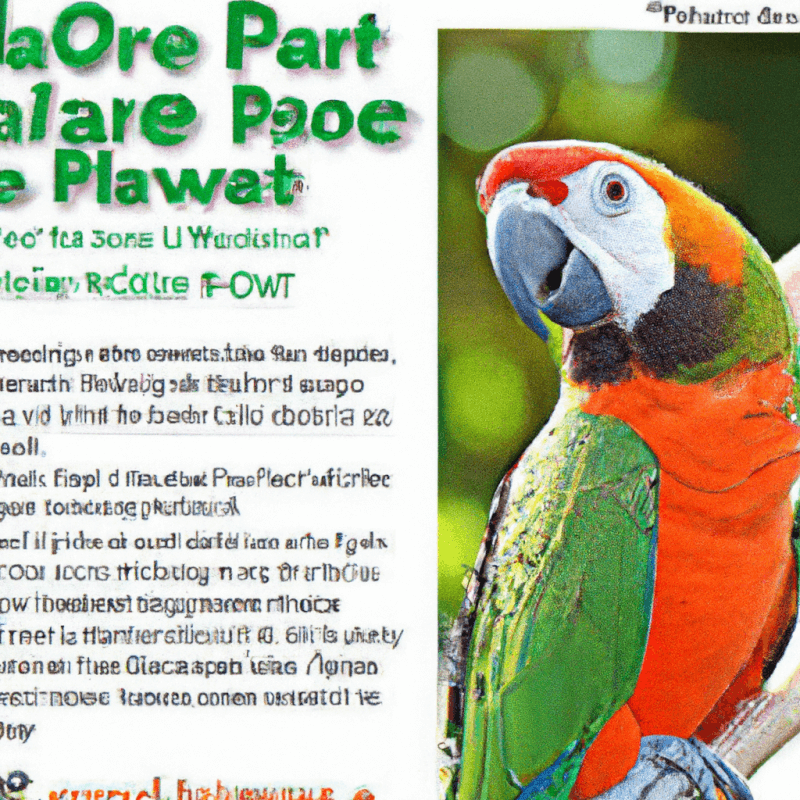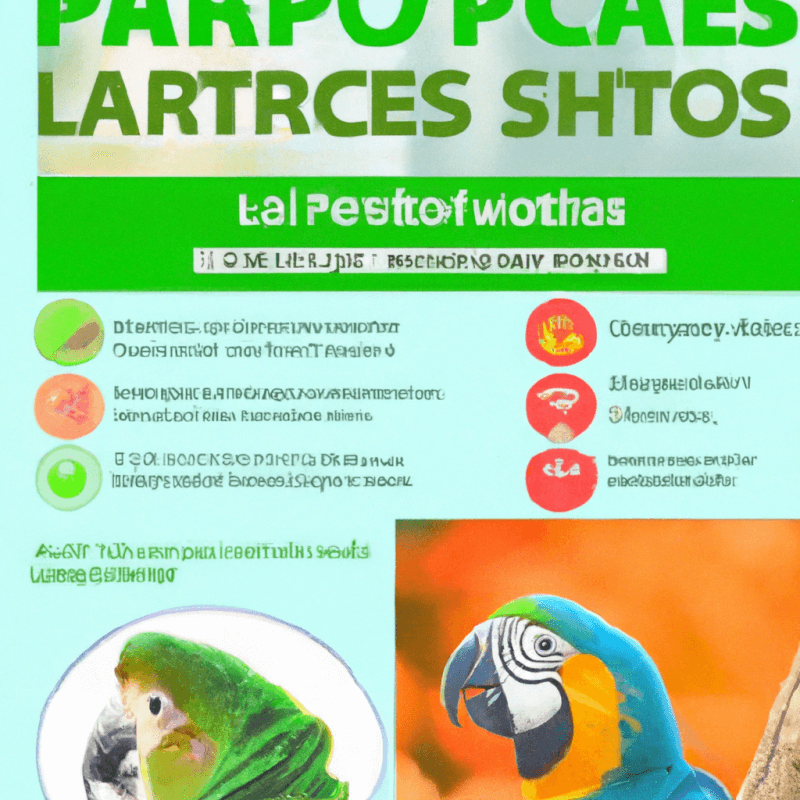Are you a proud new owner of a pet parrot? If so, you may be wondering how to properly care for your feathered friend. From providing a nutritious diet to creating a stimulating environment, the well-being of your pet parrot requires thoughtful attention. In this article, we will explore the essential aspects of parrot care, including diet, habitat, socialization, and exercise. By following these guidelines, you’ll be well on your way to building a strong and fulfilling bond with your colorful companion.

Feeding
Feeding your pet parrot a balanced diet is essential for their health and well-being. A well-rounded diet should include a variety of foods to ensure they receive the necessary nutrients. This can be achieved by offering a mix of high-quality parrot pellets, fresh fruits, and vegetables. Parrots enjoy a wide range of fruits such as apples, berries, oranges, and bananas. Leafy greens like kale, spinach, and broccoli are excellent choices for vegetables. It’s important to remember that certain foods can be toxic to parrots, so it’s crucial to avoid feeding them avocado, chocolate, caffeine, and anything containing high levels of salt or sugar.
Ready for Cat Trivia?
Test your knowledge about cats!

Including seeds and nuts in your parrot’s diet can also provide additional nutrition. Seeds such as sunflower, pumpkin, and flaxseeds are rich in healthy fats, proteins, and minerals. Nuts are another great source of essential nutrients, but they should be fed in moderation due to their high fat content. Some suitable options include almonds, walnuts, and cashews.
Offering Fresh Fruits and Vegetables
Fresh fruits and vegetables are important components of a parrot’s diet. They not only provide essential vitamins and minerals but also add variety and flavor to their meals. When offering fruits and vegetables, it’s important to wash them thoroughly and remove any seeds or pits that could be harmful to your parrot. Make sure to introduce new foods gradually to ensure your parrot’s digestive system can adjust to the changes. Experiment with different fruits and vegetables to find out what your parrot enjoys the most, as preferences can vary among individuals.
Including Seeds and Nuts in Their Diet
Seeds and nuts should be included in your parrot’s diet in moderation. They are excellent sources of healthy fats, proteins, and minerals. However, it’s important to remember that these foods are also high in calories, so excessive consumption can lead to weight gain. Offer a variety of seeds such as sunflower, pumpkin, and flaxseeds to provide different nutrients. Nuts like almonds, walnuts, and cashews can be given as occasional treats. Remember to avoid salted or roasted nuts, as these can be harmful to your parrot’s health.
Avoiding Toxic Foods
Certain foods are toxic to parrots and should be strictly avoided. Avocado, for example, contains a toxin called persin that can be deadly to birds. Chocolate and caffeine are also harmful to parrots and can lead to serious health issues. Additionally, high-salt and high-sugar foods can negatively impact their health and should be avoided. It’s important to research and familiarize yourself with the potential hazards of certain foods to ensure the safety and well-being of your pet parrot.
Housing
Providing an appropriate cage is crucial for your parrot’s well-being. The cage should be large enough for them to move freely, stretch their wings, and engage in natural behaviors. A good rule of thumb is to choose a cage that allows at least two wingspans in width. Vertical space is also essential, as parrots enjoy climbing and perching at different heights. Opt for cages made of non-toxic materials, such as stainless steel or powder-coated metal, to ensure the safety of your pet.
Ensuring Proper Cage Size
Choosing the right cage size for your parrot is essential to their overall health and happiness. The cage should be spacious enough to accommodate their movements and provide ample room for toys, perches, and food bowls. Parrots require enough space to stretch their wings and engage in natural behaviors like climbing and hopping. A cage that is too small can lead to stress, boredom, and even physical health issues. Research the specific needs of your parrot species to determine the appropriate cage size, and consider upgrading to a larger cage if necessary.
Providing Perches and Toys
Parrots are highly intelligent and active birds that require mental and physical stimulation to thrive. Providing a variety of perches and toys can help keep them entertained and prevent boredom. Natural wood perches of different shapes and sizes are great for maintaining foot health and giving your parrot a place to rest. Include toys that encourage interaction and engagement, such as puzzles, chew toys, and foraging toys. Regularly rotate and introduce new toys to keep your parrot’s environment interesting and stimulating.
Creating a Comfortable Environment
Creating a comfortable and enriching environment within the cage is essential for your parrot’s well-being. Use natural materials such as untreated wood, ropes, and branches to create a stimulating and visually appealing space. Consider placing the cage in an area where your parrot can observe the household activity while still feeling safe and secure. Provide a variety of perches at different heights to simulate their natural habitat, and ensure that the cage is warm, draft-free, and well-ventilated. Regularly clean and sanitize the cage to maintain a healthy living environment for your parrot.
Socialization
Socialization is key to developing a strong bond with your parrot and ensuring their happiness. Spending quality time with your parrot on a daily basis is essential for their emotional well-being. Parrots are highly intelligent and social creatures that require mental stimulation, social interaction, and companionship.
Spending Quality Time with Your Parrot
Dedicating quality time to interact with your parrot is vital for their overall happiness and well-being. Parrots thrive on socialization and enjoy the company of their human companions. Set aside time each day to spend with your parrot, engaging in activities that they enjoy. This can include talking to them, singing, or simply sitting near them quietly. As you develop a routine, your parrot will come to anticipate and appreciate your presence, strengthening the bond between you.
Engaging in Interactive Activities
Parrots are intelligent animals that require mental stimulation to prevent boredom and behavioral issues. Interactive activities such as puzzles, training sessions, and foraging games can fulfill their need for mental engagement. Teach your parrot simple commands and tricks using positive reinforcement techniques. This not only stimulates their mind but also helps build trust and establishes you as their trusted caregiver.
Teaching Basic Commands and Tricks
Teaching basic commands and tricks to your parrot is not only fun but also provides mental stimulation and strengthens the bond between you. Start with simple commands like “step up” or “wave,” using positive reinforcement techniques such as treats and praise. Once your parrot has mastered basic commands, you can progress to more complex tricks like retrieving objects or playing dead. Patience and consistency are key when training your parrot, so be sure to reward their efforts and maintain a positive and encouraging atmosphere.
Introducing to New Experiences
Parrots thrive on new experiences and enrichment. Introduce your parrot to a variety of stimuli, such as different toys, sounds, and textures. Take them outside for supervised outdoor time, allowing them to experience fresh air, sunlight, and new sights and sounds. Gradually exposing your parrot to new experiences will help them develop confidence and adaptability. Always prioritize their safety and well-being, ensuring that any new experiences are positive and stress-free.
Healthcare
Maintaining your parrot’s healthcare is crucial for their long-term well-being. Regular veterinary check-ups, proper hygiene practices, and monitoring for signs of illness are essential aspects of caring for your pet parrot.
Regular Veterinary Check-ups
Regular veterinary check-ups are vital to ensure your parrot’s health and address any potential issues early on. Find a reputable avian veterinarian who specializes in treating birds, as they will have the expertise necessary to provide proper care for your parrot. Schedule routine check-ups at least once a year, or more frequently, depending on the age and condition of your parrot. During these visits, the veterinarian will conduct a thorough examination, assess your parrot’s overall health, and provide any necessary vaccinations or treatments.
Maintaining Proper Hygiene
Maintaining proper hygiene practices is essential to prevent the spread of disease and keep your parrot in optimal health. Clean the cage and accessories regularly, removing any droppings, uneaten food, or soiled bedding. Replace the cage lining, perches, and toys as needed. Provide fresh clean water daily and wash food bowls and water dispensers regularly to prevent bacterial growth. Proper hygiene not only prevents the buildup of harmful bacteria but also ensures a clean and comfortable living environment for your parrot.
Trimming Nails and Wings
Regular nail and wing maintenance is crucial for your parrot’s safety and well-being. Overgrown nails can become painful for your parrot and may even cause injury or lead to an imbalance in their posture. Trimming the nails every few weeks, or as needed, helps prevent these issues. Similarly, trimming the flight feathers on your parrot’s wings ensures their safety and prevents potential accidents. While it is possible for trained professionals to assist with wing trimming, it’s essential to research and consult with an avian veterinarian or experienced bird groomer to ensure the procedures are done safely and with the least amount of stress for your parrot.
Monitoring for Signs of Illness
Monitoring for signs of illness is a crucial aspect of caring for your pet parrot. Parrots are highly skilled at hiding signs of illness, so it’s important to pay close attention to any changes in their behavior, appetite, or droppings. Signs of illness can include changes in vocalization, sneezing, coughing, loss of appetite, weight loss, excessive feather plucking, or changes in droppings’ color, consistency, or frequency. If you notice any of these signs or if your parrot is acting differently, consult with an avian veterinarian immediately. Early detection and prompt treatment are essential in ensuring a favorable outcome for your parrot’s health.

Exercise
Providing your parrot with ample opportunities for exercise is crucial to their physical and mental well-being. Parrots are naturally active and agile creatures that require regular exercise to maintain a healthy weight, promote cardiovascular health, and prevent boredom.
Providing Ample Flight Opportunities
Flight is a natural behavior for parrots, and being able to fly provides them with essential exercise and mental stimulation. If your parrot’s wings are not trimmed, ensure that they have a safe and open space to fly within your home or in a designated flight area. Remove any hazards such as ceiling fans or open windows to prevent potential accidents. Regular flight exercise not only promotes physical well-being and muscle tone but also allows your parrot to engage in their natural instincts.
Encouraging Physical Activities
In addition to flight, provide a variety of physical activities to keep your parrot active and healthy. Consider installing bird-safe ladders, swings, and ropes to promote climbing, swinging, and hanging. Provide ample space for your parrot to move and explore by arranging perches at different heights and incorporating platforms or branches within their environment. Interactive toys such as balls, bells, and puzzle toys can also encourage physical activity while simultaneously providing mental stimulation.
Engaging in Mental Stimulation
Parrots are intelligent creatures that require mental stimulation to prevent boredom and promote overall well-being. Incorporate regular mental exercises into your parrot’s routine to keep their mind active and engaged. This can include training sessions, interactive toys, and foraging activities. Teach your parrot new commands or tricks, hide treats within foraging toys, or rotate toys regularly to provide new challenges. Mental stimulation not only keeps your parrot entertained but also helps prevent behavioral issues that can arise from boredom or lack of mental engagement.
Allowing Supervised Outdoor Time
Providing supervised outdoor time can offer your parrot additional exercise opportunities while allowing them to experience nature and fresh air. Harness training or utilizing an outdoor aviary can provide a safe and controlled environment for your parrot to explore the outdoors. Ensure that the outdoor area is free from potential hazards, such as toxic plants, predators, or extreme weather conditions. Supervision is crucial to ensure your parrot’s safety and to prevent any accidental escapes. Outdoor time offers your parrot mental and physical stimulation, helping to enrich their daily routine.
Training
Training your pet parrot is not only an enjoyable experience but also an essential part of their well-being. Positive reinforcement techniques, basic commands, addressing behavioral issues, and encouraging sociability are key aspects of parrot training.
Using Positive Reinforcement
Positive reinforcement is a highly effective training technique that utilizes rewards to reinforce desired behaviors. When your parrot demonstrates the desired behavior, such as stepping onto your hand or performing a trick, reward them with praise, treats, or their favorite toy. This positive association encourages your parrot to repeat the behavior in the future. Using positive reinforcement not only increases the bond between you and your parrot but also creates a positive and trusting environment for learning and growth.
Teaching Basic Commands
Teaching your parrot basic commands is an important part of their training and can help establish clear communication between you. Start with simple commands such as “step up,” “stay,” or “come here,” using a consistent verbal cue for each command. Utilize positive reinforcement techniques to reward your parrot when they correctly respond to the command. Be patient, as each parrot learns at their own pace, and remember to keep training sessions short and engaging to maintain their focus and enjoyment.
Addressing Behavioral Issues
Parrots, like any pets, can develop behavioral issues that may need to be addressed during training. Common behavioral issues in parrots can include excessive vocalization, feather plucking, biting, or aggression. If you notice any concerning behaviors, it’s important to address them promptly and seek guidance from a parrot behavior specialist or an avian veterinarian. Understanding the root cause of the behavior and implementing a consistent positive reinforcement-based training plan can help address and modify these behaviors effectively.
Encouraging Sociability
Parrots are social creatures that thrive on interaction and companionship. Encouraging sociability through training and socialization experiences can help your parrot develop positive relationships and improve their overall well-being. Provide opportunities for your parrot to interact with other family members, pets, or even other parrots in a controlled and supervised environment. Engaging in regular training sessions and interactive activities will not only strengthen their bond with you but also enhance their sociability and adaptability to various social situations.

Communication
Understanding your parrot’s communication cues is crucial for building a strong bond and maintaining effective communication. Through body language, vocalizations, and other gestures, parrots express their emotions, needs, and desires.
Understanding Parrot Body Language
Parrots communicate a wealth of information through their body language. Paying attention to their posture, feather position, tail movements, and eye dilation can provide insights into their emotions and overall well-being. For example, fluffed feathers may indicate illness or discomfort, while raised crests may indicate excitement or alertness. Tail wagging or fanning can express various emotions, such as curiosity or aggression. Familiarize yourself with your parrot’s specific body language to better understand their needs and emotions.
Developing a Unique Communication Style
Parrots appreciate a consistent and unique communication style from their human companions. Create a distinct vocalization or whistle that you can use to communicate with your parrot. This personalized communication cue helps establish a connection and understanding between you and your parrot. Parrots are known for mimicking sounds and words, so incorporating a unique vocalization specific to your interactions can further enhance your bond and mutual communication.
Recognizing Vocalizations and Gestures
Parrots use vocalizations and gestures to communicate a wide range of messages. They may vocalize to express hunger, contentment, or discomfort. Listen to your parrot’s vocalizations to identify their needs and respond accordingly. Additionally, parrots use gestures such as head bobbing, wing flapping, or beak tapping to convey specific messages. Pay attention to these gestures, as they can provide important clues about your parrot’s current state or requirements. By familiarizing yourself with your parrot’s vocalizations and gestures, you can better understand and meet their needs.
Maintaining Trust and Bonding
Communication plays a crucial role in building trust and maintaining a strong bond with your parrot. Consistent, patient, and positive interactions build trust over time. Avoid sudden movements, loud noises, or actions that may startle or frighten your parrot. Respond to their vocalizations, gestures, and body language in a calm and reassuring manner. Consistency and understanding are key to developing a strong bond built on trust, ensuring a happy and fulfilling relationship between you and your parrot.
Grooming
Regular grooming is essential to maintain your parrot’s overall health and appearance. Bathing and showering, brushing feathers, cleaning the beak and nails, and inspecting for signs of abnormalities are important aspects of parrot grooming.
Bathing and Showering
Regular bathing or showering is crucial for your parrot’s feather health and cleanliness. While some parrots may enjoy a gentle mist of water from a spray bottle, others may prefer a shallow dish of water for bathing. Observe your parrot’s preferences and provide a bathing opportunity accordingly. Regular bathing helps remove dust, dirt, and excess oil from their feathers, keeping them clean and in good condition. Ensure the bathing area is safe and free from any potential hazards, and always use lukewarm water to avoid discomfort or chilling.
Brushing Feathers
Brushing your parrot’s feathers helps remove dust, dander, and loose feathers while promoting blood circulation and stimulating the oil glands. Use a soft, bird-specific brush or a clean, soft cloth to gently brush through their feathers. Approach brushing with care and observe your parrot’s reaction to ensure they are comfortable with the process. Regular brushing helps maintain the overall health and beauty of their feathers.
Cleaning Beak and Nails
Regularly cleaning your parrot’s beak and nails is essential to prevent discomfort and potential health issues. Use a soft, damp cloth to gently wipe the beak, removing any food debris or buildup. Be cautious and avoid excessive pressure, as the beak is sensitive. Trimming your parrot’s nails helps prevent overgrowth and potential injuries. It’s important to learn the proper technique for nail trimming or seek assistance from an avian veterinarian or experienced bird groomer to prevent accidental injury to your parrot.
Inspecting for Signs of Abnormalities
Regularly inspecting your parrot’s physical condition is crucial for detecting any abnormalities or signs of health concerns. Look for changes in feather quality, skin condition, or beak and nail health. Observe their eyes for any discharge, swelling, or cloudiness. Additionally, check their vent area for any signs of irritation or discharge. If you notice any abnormalities, consult with an avian veterinarian for appropriate diagnosis and treatment.

Environment
Providing a safe and comfortable living environment is essential for your parrot’s overall well-being. Regulating temperature and humidity, minimizing stress factors, and avoiding exposure to harmful substances are key aspects of creating a suitable environment for your pet.
Providing a Safe and Secure Space
Creating a safe space for your parrot is crucial to ensure their physical well-being. Ensure that their cage is free from any potential hazards such as toxic plants, sharp objects, or loose wires. Keep chemicals, cleaning agents, and other potentially harmful substances securely stored, well out of their reach. Regularly inspect their environment for any potential safety concerns and promptly address them to maintain a secure living space for your parrot.
Regulating Temperature and Humidity
Parrots are sensitive to extreme temperature and humidity fluctuations, so it’s important to maintain a stable and comfortable environment for them. Research the specific temperature and humidity requirements for your parrot species and adjust their living conditions accordingly. Use a thermometer and hygrometer to monitor the cage’s temperature and humidity levels, and provide heating or cooling solutions as needed. Avoid placing the cage in drafty areas or near direct sources of heat or cold as they can cause stress and potential health issues.
Minimizing Stress Factors
Stress can have a detrimental impact on your parrot’s overall health and well-being. Minimizing stress factors in their environment is crucial to ensure a happy and contented parrot. Avoid sudden loud noises, frequent changes to their environment, and disruptions to their routine. Provide a consistent feeding and socialization schedule. Parrots thrive on routine and familiarity, so maintaining a stable and stress-free environment is essential for their overall happiness and health.
Avoiding Exposure to Harmful Substances
Parrots are highly sensitive to toxic substances, so it’s essential to avoid exposing them to harmful substances. Common household items such as cleaning agents, insecticides, candles, and certain plants can be toxic to parrots if ingested or their fumes are inhaled. Familiarize yourself with common household toxins and ensure they are kept securely stored and out of your parrot’s reach. Research the safety of any new products or plants before introducing them to your parrot’s environment. By maintaining a toxin-free environment, you can help ensure the well-being and longevity of your pet parrot.
Breeding
Breeding parrots should only be undertaken with careful consideration and thorough knowledge of the breeding process. Understanding the breeding cycle, creating a suitable nesting area, assisting with incubation if necessary, and providing appropriate care for the fledglings are important aspects of parrot breeding.
Understanding the Breeding Cycle
Before considering breeding your parrots, it’s important to understand the breeding cycle and the responsibilities it entails. Parrots have specific breeding seasons during which they are most sexually active. Proper nutrition, environmental conditions, and sufficient bonding time are crucial factors that influence the success of breeding. Research the specific breeding requirements of your parrot species and consult with experienced breeders or avian veterinarians to ensure you are prepared for the breeding process.
Creating a Suitable Nesting Area
Providing a suitable nesting area is essential for a successful breeding environment. Parrots require a nest box or nesting area that simulates their natural habitat. The size and design of the nest box should correspond with the specific needs and characteristics of your parrot species. Provide nesting materials such as untreated wood shavings, coconut fiber, or straw so the female parrot can build a suitable nest. Ensure the nesting area is secure, well-ventilated, and easily accessible for cleaning and monitoring.
Assisting with Incubation, If Necessary
In some cases, parrots may require assistance with incubation to ensure successful hatching of the eggs. It’s important to identify when and if intervention is necessary, as incorrect incubation can lead to poor hatch rates or health issues in the chicks. Consult with an experienced avian veterinarian or breeder for guidance on when and how to assist with incubation. Maintain proper temperature and humidity levels during the incubation period, and handle the eggs with extreme care to avoid damage or contamination.
Caring for the Fledglings
Once the eggs hatch and the fledglings emerge, providing appropriate care is essential for their growth and development. Offer a balanced and nutritious diet specific to the species and age of the fledglings. Monitor their health closely and consult with a veterinarian to ensure they receive the necessary vaccinations and treatments. Provide a safe and secure environment for the fledglings to explore and develop their natural behaviors. Allow appropriate time for socialization and bonding with their parents, and only consider separating them once they are fully weaned and independent.
Caring for a pet parrot requires dedication, knowledge, and a genuine love for these intelligent and social creatures. By providing a balanced diet, a comfortable living environment, engaging in socialization and training, maintaining proper healthcare, and attending to their grooming and environmental needs, you can ensure the happiness and well-being of your beloved feathered friend. Always be observant and responsive to your parrot’s behaviors and needs, and consult with professionals when necessary to give your parrot the best care possible. With proper care and attention, your parrot will thrive and bring you joy for many years to come.



